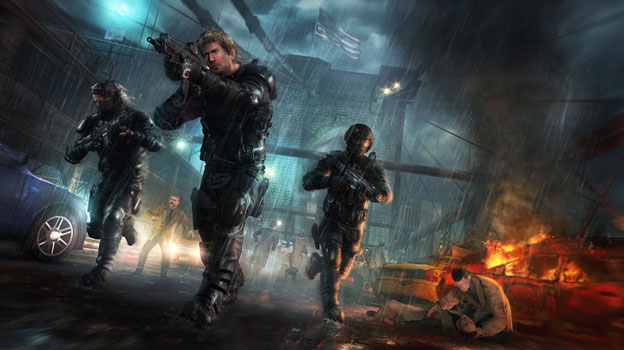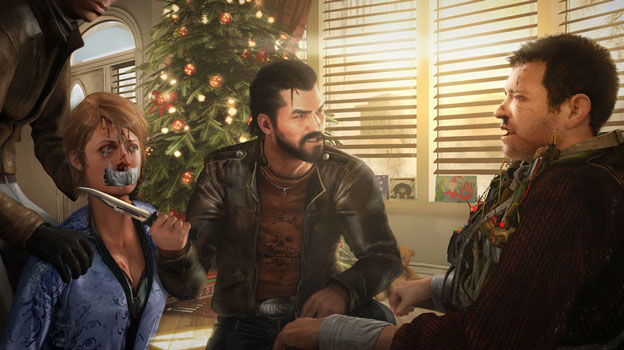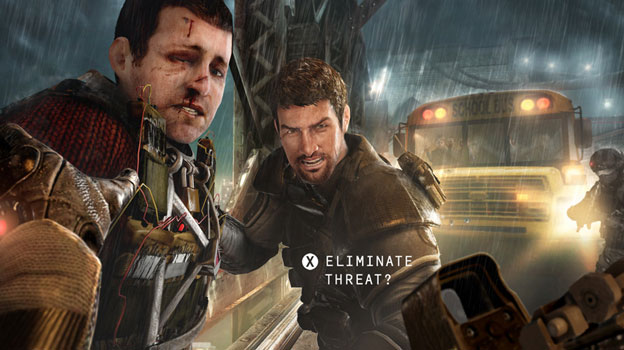The Path Of Ethical Resistance
Morality has become this big thing in games over the last ten years or so. It’s not that there weren’t games that judged you on your actions before then, but I’d argue that it was the incredible critical and commercial success of Star Wars: Knights of the Old Republic that cemented the idea that gamers wanted to be rewarded and punished for the decisions they made in games. As always, though, with time, the industry began to call for greater complexity in these morality systems, for more wiggle-room within a moral grey area rather than static “good” and “evil” options. Fast-forward to 2011 and the reveal of Tom Clancy’s Rainbow 6: Patriots, with which Ubisoft is hoping to add “an unprecedented level of humanity that will make [it] an extremely tense and immersive experience.” They intend to add this “humanity” by forcing the player’s hand in lose-lose situations, forcing one to pick the lesser of two evils.
This attitude is apparent from the get-go. The first choice they’ve demonstrated involves a man with a bomb strapped to his chest, his family held hostage unless he successfully suicide bombs Times Square. When a remote detonator activates and the bomb on his chest starts counting down, you are expected to toss him off of a bridge, saving the lives of countless civilians and condemning his family. Or should you co-opt your squad leader and attempt to disarm the bomb, potentially leading to the deaths of many more? Rainbow 6: Patriots puts the ball in your court, the decision in your hands.

Further, the terrorists in this game—as Rainbow 6: Patriots is still a squad-based counter-terrorism title—are designed to hit close to home. The “True Patriots,” as they call themselves, rail against the corporate psychology of the United States, the preservation of large, multi-national businesses that “streamline” jobs and take “bailouts” to improve their profit margins. A clear parallel of the still-hot-button Occupy movement, the True Patriots’ methods are far less peaceful and more organized. The VGA trailer for the game shows them breaking into a high rise office in New York, strapping explosives to an aged executive, and hurling him out the window, detonating the bomb as he hits the pavement and sending taxis careening off the street in all directions.
This is a game about perspective. The Call of Duty series has become famous for this, but other titles, such as Halo 2, have played with changing a player’s role when it’s felt to be dramatically appropriate, or to offer some insight into the “other half.” Ubisoft has stated that their intention is for an 80-20 split, with the majority of the player’s time spent controlling members of Rainbow squad, the remainder spent in the heads of civilians, emergency response personnel, even members of the terrorist movement when appropriate.

Rainbow Six: Patriots wants to push the envelope on good taste, putting civilians in the line of fire, asking you, at times, to focus on officers of the law when communication simply won’t be fast enough. The target trailer shows the would-be player shooting them in the legs, incapacitating them so that they don’t kill the man holding the dead-man switch and set him off on the bridge. This also displays the game’s proposed augmented reality elements, which paint enemies in the environment and use floating icons to draw one’s attention to threats and friendlies alike.
Gameplay itself appears to change little with the basic Rainbow Six formula, as it was when the Vegas entries came out years ago. Though the AR interface stands in for one’s snake cam, it is still possible to paint enemy targets in a room before breaching, but the instructions one can provide to one’s squad have been refined, with greater levels of granular detail in one’s repertoire. Denote one foe as the focus for a smoke grenade, another as the first target when you breach the room. Actions can be prioritized to ensure that the A.I. acts in a manner that is conducive to your play-style and avoids fumbling about awkwardly as it has in games past. It’s further worth noting that voice commands, for the single-player, will be making their return. The satisfaction such a seemingly minor feature can provide should not be underestimated until one has actually experienced it.

Further, multiplayer also directs the focus more to tactics, introducing new tools that facilitate them, such as the Sandtable: a holographic simulacrum of any given multiplayer map that players can visit and explore, whether on their own or as a team, to plan out their strategy and routes through the level. These plans can be saved and then called upon during a match, providing would-be squad leaders a real chance to flex their tactical muscle. Other attributes of multiplayer are designed to enhance teamwork, such as enemies spotted by one player remaining “marked” and visible for that player’s teammates, much like tagging targets in Army of Two or Ubisoft’s own Splinter Cell: Conviction.
Will Rainbow Six: Patriots offer a more engaging story than we’ve seen in entries past? Will its take on morality and the tough questions that compose it resonate with gamers? Is the expansion of its tactical arsenal going to undermine the usefulness of real tactical know-how in its multiplayer, or instead better facilitate it? The answers to these questions are a long way off, with the game not planned to be out for at least another full year. But, until then, we can wonder and maybe even give Ubisoft some ideas worth thinking about.
Game Features:
